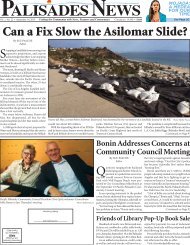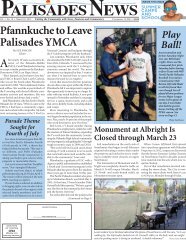Palisades-News-June-3-2015-
Palisades-News-June-3-2015-
Palisades-News-June-3-2015-
- No tags were found...
You also want an ePaper? Increase the reach of your titles
YUMPU automatically turns print PDFs into web optimized ePapers that Google loves.
<strong>June</strong> 3, <strong>2015</strong> <strong>Palisades</strong> <strong>News</strong> Page 15Reeves to Discuss His WWII Book, InfamyBy LIBBY MOTIKAStaff WriterThe story of the Japanese Americaninternment during World War II iscynically extraordinary in three differentways: the expedient mobilization ofJapanese Americans within 48 hours of thebombing of Pearl Harbor; the U.S. government’sabrupt abrogation of the civil rightsof American citizens, and finally, the stoicacceptance of the evacuees.In Infamy: The Shocking Story of theJapanese American Internment in WorldWar II, best-selling author and journalistRichard Reeves outlines the story, from thegovernment’s conviction that JapaneseAmericans presented a security threat, tothe hostility towards Japanese Americanswhile incarcerated and finally to the aftermathand reflections on what is the bestand worst of America.Reeves, a former resident of Pacific Pali -sades who now lives in Westwood, will talkabout the book and sign copies at the Pali -sades Branch Library on Thursday, <strong>June</strong>18 at 6:30 p.m. His talk is sponsored by theFriends of the Library.Most Americans have heard about theinternment camps; some have visited Man -zanar, the most widely known of 10 campswhere more than 120,000 Japanese Americanswere incarcerated during the war.But in Infamy we come to understand thecomplicity of so many “honorable” Americansin sequestering the Japanese Americans.The surprise attack on Pearl Harborfueled a belief that Japanese Americanswere allied with the enemy and assisting ina clandestine invasion. Hysteria swept theWest Coast.“The good people, the ‘Great Americans’were behind it,” Reeves says. “Walter Lippmann,Edward R. Murrow, Dr. Seuss, EarlWarren and Roosevelt. This stuff wasn’tthat unusual in those days. Roosevelt wascomfortable with the casual racial mythsthat had emerged in the U.S. in the 1920s.He speculated that the reason Japanesewere ‘devious and treacherous’ was theshape of their skulls—less developed skulls,‘two thousand years behind Caucasians.’”Lippmann, the most respected columnistin Washington, D.C., wrote an incendiarycolumn in the Washington Post inFebruary 1942 that was carried in 250 othernewspapers warning that the Pacific Coastwas in danger of an attack from within andwithout, despite no signs of sabotage.Lippmann’s column persuaded all membersof Congress from the West Coast towrite to President Roosevelt recommending“immediate evacuation of all persons ofJapanese lineage and all others, aliens andcitizens alike, whose presence shall bedeemed dangerous or inimical to the defenseof the United States from all strategic areas.”Theodor Seuss Geisel’s cartoon in a NewYork newspaper showed multitudes ofRichard Reeves’ book recounts the Japanese American internment in World War II.bucktoothed, squint-eyed Japanese linedup across the entire West Coast to be givenpacks of dynamite at a stand called “HonorableFifth Column.” The caption read:“Waiting for the signal from home.”Roosevelt issued Executive Order 9066authorizing evacuations as a matter of“military necessity.”First, assembly centers were establishedto house more than 100,000 Japanese onthe West Coast and Arizona while the WarRelocation Authority built permanentconcentration camps east of the SierraNevada and Cascade mountains.In California’s largest cities, posters instructedwhere and when Japanese aliensand Japanese Americans were expected toarrive and be carried away by buses andtrains to the holding centers.Farmers, fisherman and shop ownerslost their property, often forced to give itaway free.“It was greed, hysteria and racism thatfueled the roundup,” Reeves says. “We werein much more danger from the Germans.But if we had done the same thing to theGermans and Italians, it would have been50 million people rather than 120,000 andobviously you couldn’t run the country. APhoto: Patricia Williamsthird of the country would be in concentrationcamps.”The Japanese were ideal prisoners,Reeves concludes. Their practice of gaman,a teaching of Zen Buddhism that means“enduring the seemingly unbearable withpatience and dignity,” accounted for theirstoic endurance and pliant obedience aswell as their tremendous resourcefulness.At Manzanar, a barren, inhospitable slabof desert at the base of the Sierra Nevada,with freezing winter temperatures andscorching summers, the evacuees made thearea bloom with over 36 different vegetables,rice paddies and even fisheries.In telling the story of this reprehensiblechapter in American history, Reeves reliedon memoirs and oral histories of peoplein the camps, which gives a face to thosewho endured the humiliation.The Uchida family of Berkeley had ninedays to move. They were transported toan assembly center on the central coast,before settling in their permanent relocationcamp on a high and windy plateau insouthwest Utah.An educated family, the Uchidas wereshocked by the barbed wire perimeter, thepowdery dust that blanketed the barrackcity they would call home, and the absenceof any privacy as 8,000 residents packed themile-square camp.Reeves read government papers, lettersand accounts of meetings between Rooseveltand everyone else involved in theevacuation, and finally military records forthe all-Nisei 442nd Regimental CombatTeam, which was the most decorated unitin Army history.We learn of the valiant courage of BenKuroki, who enlisted in the United StatesArmy Air Corps, overcame overt hostilityand racism from the other enlistees, andeventually flew 58 bombing missions overGerman, Italy and Japan.When the war ended, life for the incarceratedJapanese Americans was foreverchanged. Few were able to return to theirprewar lives. Many of the older evacuees,the Issei, had to start over, more than threequartersof them without money or property.Thousands of their children madenew lives in other parts of the country.“Nobody paid any attention to them inIndianapolis and other Midwest cities, becausethere hadn’t been Japanese there before,”Reeves says. “And they felt safe. Nobodytalked about what had happened to themfrom 1942 to 1945. Parents and grandparentswere ashamed to talk about the camps,and the young ones learned not to ask.”Reeves, the author of a number of acclaimedbooks about America, its bestmoments (the Berlin Airlift) and darkest(Richard Nixon), views the shamefultreat ment of the Japanese Americans withcaution. “This is my conclusion,” he says.“We are perfectly capable of doing it again.We always say, never again, but it did happenhere.“I wrote the book because we would dothe same things to Muslims tomorrow. It’sour history. People who came here werealways mistreated, whether it was the Irishor Polish, because they weren’t like us, untilthey were us.”














